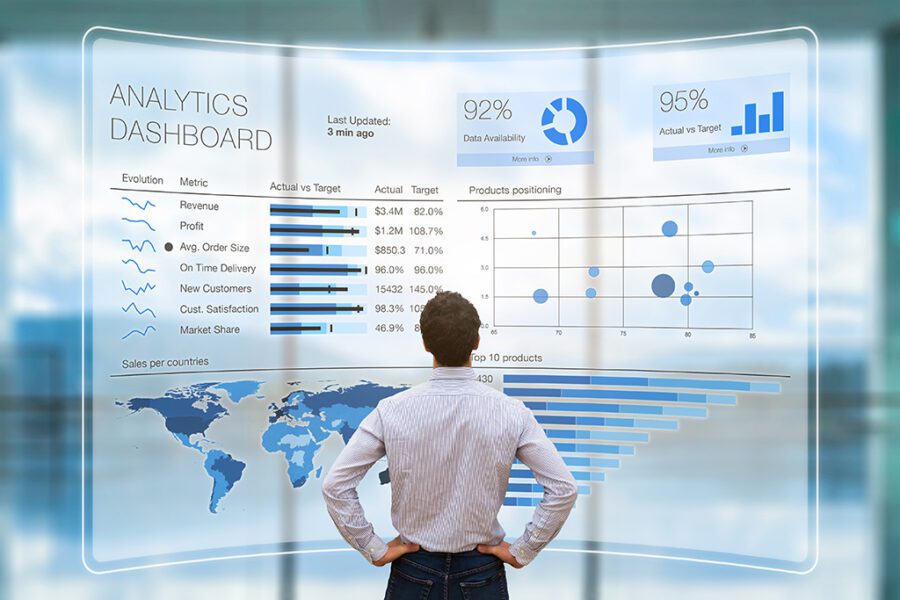Data is an asset which has become an integral aspect of business. It is able to either make or break an organization. Power BI and Microsoft Fabric are powerful tools that businesses make use of to maximize the value of data. These platforms form the basis of business intelligence and when combined with Azure Data Factory, they transform into a formidable force in data analytics and decision-making.
Power BI – Your Business Intelligence Companion
Power BI by Microsoft is an effective business intelligence program which allows businesses to display and share their data. Power BI allows users to build interactive dashboards and reports that transform raw data into actionable data.

Power BI is scalable to satisfy your business’s requirements. It seamlessly integrates with a variety of data sources which makes it much easier to merge data from several platforms and databases. Even non-technical users can use it to quickly create meaningful reports and analyses with its intuitive drag-and-drop interface.
Power BI supports real-time processing of data, making sure that you have up-to-date information. Power BI provides a variety of visualisations that allow you to present information in a stimulating and easy to digest. The ability to collaborate and share reports with colleagues enhances decision-making and promotes a data-driven culture within your business.
Microsoft Fabric The Fabric Together of Data Excellence
Microsoft Fabric is a fundamental framework that connects and manages the data gathered from different Microsoft services. It is the fabric that transforms your data into an easily accessible and usable entity. This enables businesses to gain insight quickly.
Microsoft Fabric helps businesses maintain data integrity and consistency as they deal with increasing data volumes. Microsoft Fabric integrates a wide range of applications, including Azure Data Lake Storage (Azure SQL Data Warehouse), Power BI, and many more. This connectivity ensures that information flows seamlessly and that insight can be drawn from diverse sources.
The versatility of Microsoft Fabric is particularly evident in its data transformation capabilities. Make use of it to cleanse and prepare data to be analysed. You can also use it to make sure that data is in line to your organization’s guidelines on data governance. Microsoft Fabric makes sure that your data is correct as well as reliable and ready for analysis.
Azure Data Factory: the Gateway to Data Transformation
Azure Data Factory is another crucial component of the contemporary business intelligence landscape. It’s a cloud-based integration service that permits you to build, plan and control data-driven workflows. Azure Data Factory allows for insightful insights by orchestrating the transformation of data and its movement.
Azure Data Factory comes with many advantages, among them its capability to connect to various data sources. No matter if your data is stored in the cloud or on premises You can connect it seamlessly to create a full overview of your data’s ecosystem. The platform is able to handle batch processing, real-time data streams, and big data analytics, making it a good fit for a wide range of applications.
Azure Data Factory offers a visual interface that facilitates the process of creating data pipelines. It’s simple to design, schedule, and monitor the workflow of data, even if you’re not a coder. This lets users be in charge of data integration as well as self-service data prep.
Power BI with Microsoft Fabric, Azure Data Factory, and Power BI
When Power BI is combined with Microsoft Fabric and Azure Data Factory and Azure Data Factory, they form an exciting trio that can revolutionize data analytics. The way they work together:
1. Data Integration Azure Data Factory can connect to multiple data sources to ensure your data is readily available. Microsoft Fabric orchestrates the data from various services by using the data integration capabilities. It makes sure that your data is well-organized, clean and is ready to be analysed in Power BI.
2. Data Transformation: Microsoft Fabric is a essential component of data transformation. It lets you transform your data to meet the requirements of your business. If it’s data-wrangling, cleansing, or transforming it, the fabric makes sure that your data is curated to provide meaningful insights.
3. Power BI will take over after your data is refined and is ready to be used. It allows you to build visually appealing reports and dashboards and makes complex data simple to understand. You can share these information with your team, fostering data-driven decision-making.
4. Scalability: Azure Data Factory scales seamlessly to handle growing data volumes, and the combination of Power BI and Microsoft Fabric guarantees that your data is reliable and consistent as your company grows.
5. Real-time Insights: With real-time data processing capabilities, Power BI and Azure Data Factory provide real-time information that are crucial for agile decision-making.
You can also read our conclusion.
Business intelligence is changing rapidly and businesses must tap into data’s power to remain competitive. Power BI, Microsoft Fabric and Azure Data Factory are a powerful trio that can help you take your business intelligence to new levels. If you’re looking to build stunning visualizations, make sure you have that your data is consistent, or speed up processes for data, this trio includes everything you need. Make the most of data by utilizing business intelligence.